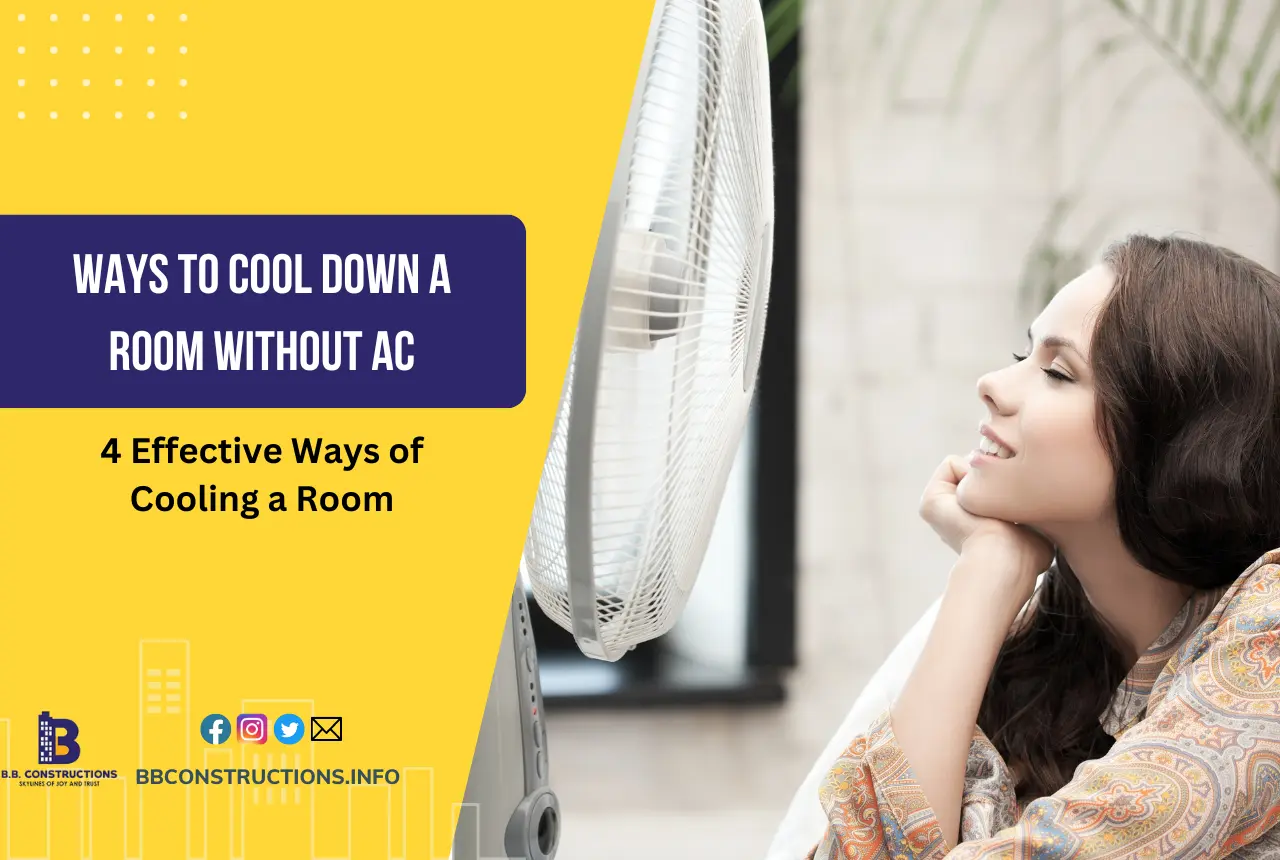![]()
As the summer heat intensifies, you might find yourself longing for a cool and refreshing indoor environment. The discomfort of hot summer temperatures can be overwhelming, and the traditional solution, air conditioning, often comes with rising energy costs and environmental concerns.
But what if there were ways you could cool down a room without AC? This cost-effective and eco-friendly approach offers a viable alternative.
Whether you’re a homeowner looking for ways to beat the heat or someone interested in sustainable living, this article will provide you with effective strategies to maintain a comfortable temperature in your home, even without the use of air conditioning.
Stay tuned as we explore these cooling methods in detail.
4 Effective Ways to Cool Down a Room Without AC
1. Block the Heat

Keeping your room cool without AC during hot summer days is crucial for comfort. Here are some effective ways to block heat and maintain a pleasant indoor environment:
Keep Windows Closed and Covered During Peak Heat Hours
One of the simplest ways to reduce heat is by keeping windows closed and covered during the hottest parts of the day. Use blinds, curtains, or blackout shades to block sunlight.
Blackout shades are particularly effective, blocking up to 99% of sunlight and significantly reducing heat. If blackout shades aren’t an option, thick, light-colored curtains can also reflect a substantial amount of heat.
Use Reflective Window Films
Applying reflective window films is another excellent way ways to cool a room without AC. These films can deflect up to 70% of solar heat, preventing it from penetrating your windows and heating up your room.
Reflective films are easy to install and can reduce indoor temperatures without obstructing your view. They also reduce glare and protect your furniture from UV damage.
Weatherproof Windows and Doors
Ensuring that your windows and doors are properly sealed can prevent hot air from entering your room. Weatherstripping is an affordable and easy solution to improve your room’s insulation.
Use adhesive-backed foam or rubber weatherstripping around windows and doors to seal gaps. Additionally, applying caulk around window frames can further block air leaks. A tight seal helps keep hot air out and maintains a cooler indoor environment.
Insulate Attics and Crawl Spaces
Proper insulation in your attic and crawl spaces is essential to prevent heat transfer. Insulating your attic with materials like fiberglass or cellulose can reduce heat gain from the roof.
Similarly, insulating crawl spaces can prevent heat from the ground from entering your room. This investment not only keeps your room cool during summer but also enhances your home’s overall energy efficiency.
Plant Trees or Install Shade Sails
Using natural shading methods can effectively reduce heat gain. Planting trees or installing shade sails outside your windows can block direct sunlight.
Trees with broad canopies, such as maples or oaks, provide extensive shade and can lower the temperature around your home. Shade sails are also an excellent option as they can be strategically placed to block the sun’s rays during the hottest parts of the day.
These solutions not only help cool your room but also add aesthetic value to your property.
By implementing these methods, you can significantly reduce the amount of heat entering your room, creating a cooler and more comfortable living space without relying on air conditioning.
2. Promote Air Circulation and Ventilation

Creating effective airflow within a room is essential for maintaining a cool and comfortable environment. Proper ventilation not only helps reduce indoor temperatures but also improves air quality.
Here are some effective methods to enhance air circulation and ventilation:
Use Ceiling Fans Strategically
Ceiling fans can significantly cool a room without AC. Ceiling fans are an energy-efficient way to enhance comfort without actually lowering the room’s temperature. To maximize their effectiveness, use ceiling fans in combination with open windows or other fans to circulate cooler air throughout the room.
Position Box Fans in Windows for Cross-Ventilation
Box fans can be strategically placed in windows to create cross-ventilation, which is especially effective at night when outdoor temperatures are lower. Position one box fan to blow cooler outside air into the room and another to expel warm indoor air out.
Cross-ventilation is a cost-effective method to refresh your living space and works best when there is a significant temperature difference between indoors and outdoors.
Consider Whole-House Fans
Whole-house fans are designed to pull in cooler outside air and expel hot indoor air through the attic. Whole-house fans are particularly effective at night when the outdoor air is cooler.
They can rapidly lower the indoor temperature, providing a comfortable environment without the need for air conditioning. Additionally, whole-house fans can help reduce humidity levels, further enhancing comfort.
3. Cool Down with Evaporation

Evaporative cooling naturally reduces temperatures by using water evaporation, which absorbs heat from the air. This method is especially effective in dry climates.
Hang a Damp Cloth or Sheet in Front of a Fan
Hang a damp cloth or sheet in front of a fan to promote evaporation. The fan blows air through the damp fabric, creating a cooling effect. Ensure good airflow for the best results. This is a quick, cost-effective way to lower room temperature.
Place a Bowl of Ice in Front of a Fan
Place a bowl of ice in front of a fan to create a cool mist as the fan blows air over the ice. This can significantly reduce room temperature and provide immediate relief from the heat, making the air feel fresher and more comfortable.
Invest in a Portable Evaporative Cooler
For a more efficient solution, consider a portable evaporative cooler. These devices draw warm air through water-soaked pads, cooling it by evaporation before circulating it back into the room. They are particularly effective in dry climates and can be a sustainable alternative to traditional air conditioning.
Using these evaporative cooling methods, you can lower indoor temperatures and create a more comfortable environment without relying on air conditioning.
Minimize Heat Generation Inside
Reducing internal heat sources can significantly help keep your room cool. By limiting activities and appliances that generate heat, you can maintain a more comfortable indoor environment.
Limit the Use of Heat-Generating Appliances
During the day, avoid using ovens and stovetops. Opt for cooking methods that produce less heat, like using a microwave, toaster oven, or preparing cold meals. Cooking in the evening when temperatures are lower can also help reduce indoor heat buildup.
Opt for Air-Drying Clothes
Instead of using a clothes dryer, which generates considerable heat, choose to air-dry your clothes. Hang them on a clothesline or drying rack. This method reduces heat in your home and saves energy, making it an eco-friendly choice.
Switch Off Lights and Electronics When Not in Use
Lights and electronic devices can generate significant heat. Turn off lights and unplug electronics when not in use. Consider using LED bulbs, which produce less heat compared to traditional incandescent bulbs. LEDs are also more energy-efficient, helping to reduce overall energy consumption.
By minimizing heat generation inside your room, you can maintain a cooler and more comfortable environment throughout the summer.
4. Manage Humidity Levels

High humidity can trap heat, making you feel hotter and more uncomfortable. Moist air holds heat more effectively than dry air, leading to a stuffy indoor environment. Managing humidity is crucial for maintaining a cooler room.
Use Dehumidifiers to Remove Excess Moisture
Dehumidifiers are effective in reducing humidity levels by removing excess moisture from the air. This is particularly beneficial in humid climates where high moisture levels exacerbate heat. Using a dehumidifier creates a drier and cooler indoor atmosphere, making the temperature feel more comfortable.
Increase Ventilation to Allow Moisture to Escape
Proper ventilation is essential for managing humidity. Increasing airflow helps expel moist air and bring in drier, cooler air from outside. Use exhaust fans in kitchens and bathrooms, and open windows to promote cross-ventilation. This reduces indoor humidity levels and prevents moisture buildup.
Take Shorter, Cooler Showers
Long, hot showers can significantly increase bathroom humidity, which can spread to other parts of your home. Taking shorter, cooler showers helps reduce the amount of moisture released into the air. Additionally, using an exhaust fan or opening a window during and after showers can help dissipate humidity more quickly.
By effectively managing humidity levels, you can create a more comfortable and cooler indoor environment, making it easier to endure hot summer days.
Conclusion
Implementing these four effective methods can significantly cool down a room without AC, ensuring a more comfortable and refreshing summer experience.
From blocking heat gain to promoting airflow and utilizing evaporative cooling, there are various strategies to choose from.
Combining multiple methods can enhance their effectiveness, providing even greater relief from the heat. Try these techniques today to beat the summer heat while saving energy and reducing your environmental impact.







